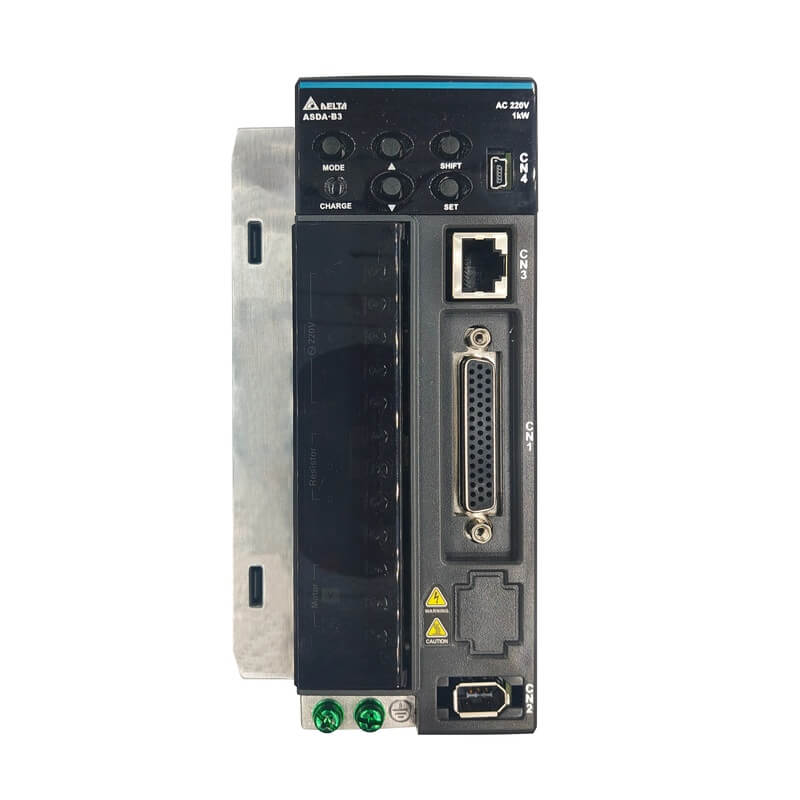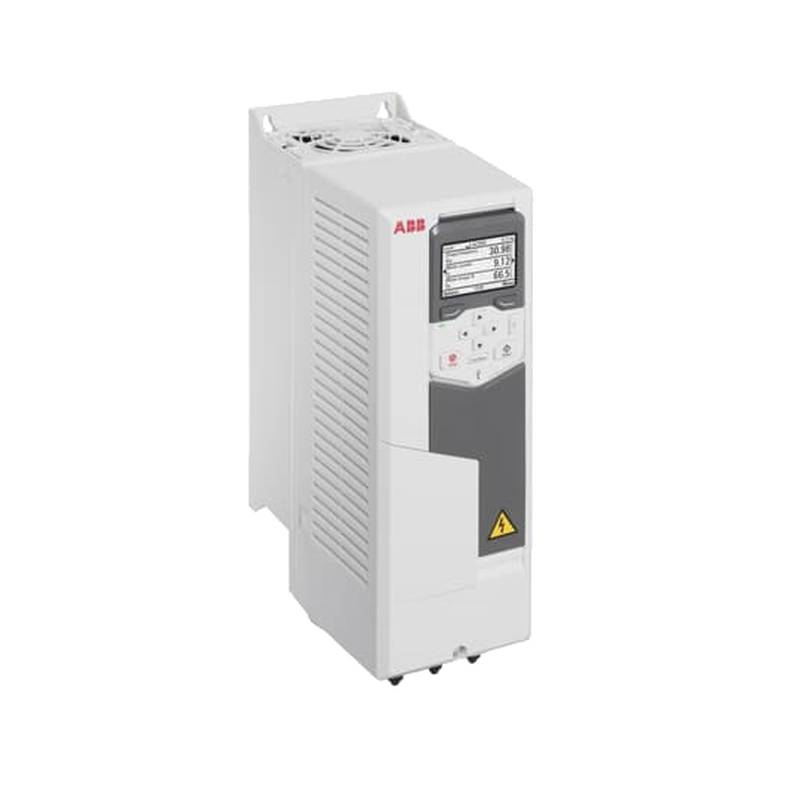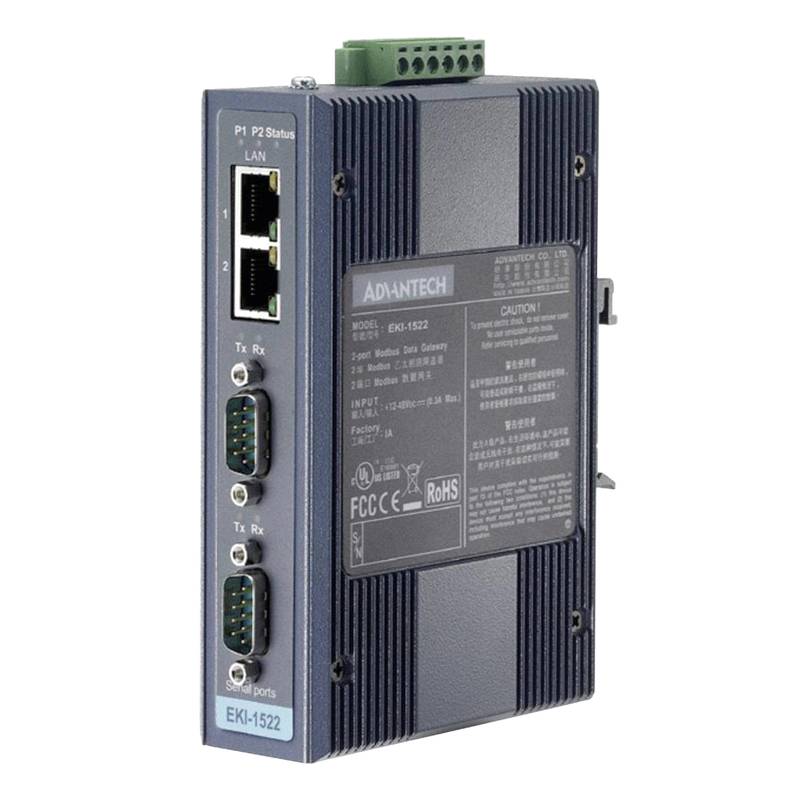
The Delta VFD3A0MH43ANSAA MS300 Universal VFD Frequency Converter is engineered for demanding industrial applications, offering robust performance and advanced control capabilities. This 3.0A, 0.75kW variable frequency drive (VFD) provides exceptional energy efficiency and precise motor speed regulation, making it an ideal solution for a wide range of machinery. Its compact design and user-friendly interface simplify installation and operation, while its advanced features ensure reliability and optimal performance in diverse environments.
Product Specifications
| Parameter | Specification |
| :--------------------- | :--------------------------------------- |
| Model | VFD3A0MH43ANSAA |
| Series | MS300 |
| Input Voltage | 3 Phase, 380-480V, 50/60 Hz |
| Output Voltage | 3 Phase, 0-380V |
| Rated Current (A) | 3.0 A |
| Rated Power (kW) | 0.75 kW (1 HP) |
| Control Method | V/f, Sensorless Vector Control |
| Frequency Range | 0.00 Hz to 600.00 Hz |
| Overload Capacity | 120% for 60 sec (Normal Duty) |
| Communication Ports | Built-in RS-485 (Modbus) |
| Protection Rating | IP20 |
| Operating Temperature | -10°C to 50°C |
| Dimensions (H x W x D) | 182 x 72 x 141.5 mm |
Core Features & Market Positioning
The Delta MS300 series, including the VFD3A0MH43ANSAA, distinguishes itself through its advanced auto-tuning capabilities for sensorless vector control, which significantly optimizes motor performance without requiring manual parameterization. This intelligent self-adjustment capability reduces commissioning time and ensures peak efficiency across varying load conditions, positioning it as a highly competitive option for applications demanding precise speed and torque control. Its built-in braking unit for higher braking torque applications further enhances its versatility and value proposition compared to standard VFDs.
Key Application Scenarios
This versatile VFD finds extensive use in numerous industrial sectors. It is particularly well-suited for driving fans, pumps, and compressors in HVAC systems, offering significant energy savings through precise speed modulation. The VFD3A0MH43ANSAA is also an excellent choice for material handling equipment, conveyors, and packaging machinery where smooth acceleration and deceleration are critical. Its robust construction and reliable operation make it suitable for textile machinery, printing equipment, and general manufacturing processes requiring accurate speed management and consistent output.
Practical System Integration Guidance
Integrating the Delta VFD3A0MH43ANSAA into existing systems is streamlined by its clear terminal layout and comprehensive documentation. For basic motor control, connect the incoming power to L1, L2, L3 and the motor leads to T1, T2, T3. Ensure proper grounding of both the VFD and the motor. The VFD supports Modbus RTU communication via its RS-485 port, allowing for seamless integration into SCADA systems or PLCs for remote monitoring and control. Initial parameter setup can be performed via the on-board keypad or through communication software, with default settings often suitable for common applications.
Operation and Risk Mitigation
Safe operation of the VFD3A0MH43ANSAA necessitates adherence to electrical safety standards and proper installation practices. Always ensure the drive is powered down and de-energized before making any wiring changes. Overcurrent (OC) and Overvoltage (OV) faults are common indicators of system issues; troubleshooting often involves checking motor load, supply voltage stability, and braking resistor configuration if applicable. The drive's built-in protection features, such as motor overload and short-circuit protection, are crucial for preventing damage, but periodic inspection of connections and environmental conditions (temperature, humidity) is recommended.
Scalability & Long-Term Value
The MS300 series, including the VFD3A0MH43ANSAA, is designed for adaptability. Its compatibility with Delta's broader automation ecosystem, including PLCs and HMIs, facilitates the creation of integrated and scalable solutions for Industry 4.0 initiatives. The VFD supports various communication protocols, enabling seamless data exchange for performance monitoring and predictive maintenance. This forward-looking design ensures that the VFD can be readily incorporated into evolving smart manufacturing environments, maximizing long-term operational value and return on investment.
Frequently Asked Questions
1. What are the primary benefits of using the Delta VFD3A0MH43ANSAA?
The VFD3A0MH43ANSAA offers significant energy savings by precisely controlling motor speed. It provides enhanced motor protection features, reducing the risk of damage. Its advanced auto-tuning for sensorless vector control optimizes performance.
This drive allows for smoother motor operation, leading to reduced mechanical stress on machinery. It also enables precise speed adjustments for various application requirements.
The compact design simplifies installation and panel space utilization. Its robust build ensures reliability in demanding industrial settings.
2. Can the VFD3A0MH43ANSAA control different types of motors?
Yes, this VFD is designed for universal application, supporting AC induction motors. It offers both V/f control and sensorless vector control modes.
Sensorless vector control provides excellent torque response and speed accuracy, even without motor feedback. This makes it suitable for a wide range of motor types and loads.
Ensure motor nameplate data is correctly entered into the VFD parameters for optimal performance and protection.
3. How do I connect the Delta VFD3A0MH43ANSAA to a motor?
Connect the incoming power supply to terminals L1, L2, and L3. Connect the motor leads to terminals T1, T2, and T3. Always verify power is off before wiring.
For control signals, use the digital input terminals (DI) for start/stop and speed selection. Analog inputs (AI) can be used for speed reference signals.
Ensure proper grounding of the VFD and motor for safety and to prevent electrical noise interference. Consult the manual for detailed wiring diagrams.
4. What is the typical power rating and current capacity of this VFD?
The VFD3A0MH43ANSAA has a rated power of 0.75 kW (1 horsepower). Its maximum output current capacity is 3.0 Amperes.
This rating makes it suitable for medium-sized motors commonly found in pumps, fans, and small conveyors. Always match the VFD rating to the motor's requirements.
Exceeding the rated current for extended periods can lead to overcurrent faults and damage to the VFD.
5. Does the VFD3A0MH43ANSAA support communication protocols?
Yes, it features a built-in RS-485 communication port. This port supports the Modbus RTU protocol.
This allows for seamless integration with PLCs, HMIs, and SCADA systems for remote monitoring and control. It enables data exchange for automation.
Users can configure communication parameters like slave ID, baud rate, and parity through the VFD's menu.
6. What are common fault codes for the Delta MS300 VFD?
Common fault codes include OC (Overcurrent), OV (Overvoltage), UV (Undervoltage), and OL (Overload). These indicate abnormal operating conditions.
Troubleshooting involves checking motor load, supply voltage, and wiring integrity. For OL faults, verify motor parameters and duty cycle.
Refer to the VFD manual for a complete list of fault codes and their specific troubleshooting steps.
7. How can I perform motor auto-tuning with the VFD3A0MH43ANSAA?
Access the VFD's parameter menu and navigate to the auto-tuning function. Ensure the motor is disconnected from the load during tuning.
Initiate the auto-tuning process through the keypad. The VFD will then measure motor parameters automatically.
Once tuning is complete, save the parameters and reconnect the motor. This optimizes performance for sensorless vector control.
8. Is the VFD3A0MH43ANSAA suitable for high-temperature environments?
The VFD3A0MH43ANSAA has an operating temperature range of -10°C to 50°C. It is rated IP20, meaning it has limited protection against dust and water.
For operation above 40°C, derating of the VFD's current output capacity is usually required. This is to prevent overheating and ensure longevity.
Ensure adequate ventilation around the VFD installation to maintain optimal operating temperatures and performance.
9. What is the difference between V/f control and sensorless vector control on this VFD?
V/f control maintains a constant ratio between voltage and frequency, suitable for simple applications like fans and pumps. It offers basic speed control.
Sensorless vector control offers superior torque response, accuracy, and dynamic performance without a motor encoder. It's ideal for demanding applications.
The MS300's auto-tuning function significantly simplifies the setup for sensorless vector control, maximizing its benefits.
10. Can I upgrade the firmware of the VFD3A0MH43ANSAA?
Yes, Delta typically provides firmware updates for their VFDs to enhance functionality or resolve issues. Check Delta's official website for available updates.
Firmware updates are usually performed via a USB connection or through the RS-485 communication port using specialized software.
Always follow the manufacturer's instructions precisely when updating firmware to avoid damaging the VFD.
























